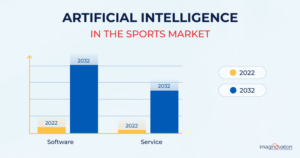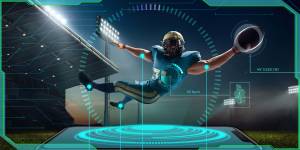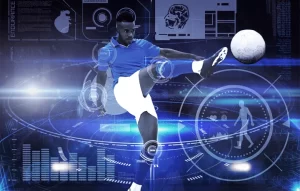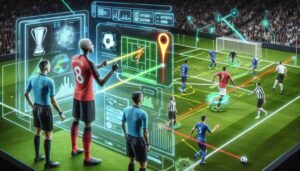The Sports Industry’s Use of AI: An Overview
In sports, artificial intelligence has a wide range of possible uses. Data indicates that the sports industry’s AI market could grow to be worth 19.2 billion dollars by 2030 due to its increasing ubiquity.
Here is an illustration of a practical application: Using AI, a lot of data may be analyzed to find trends and patterns. Using this data can help you comprehend the game better, play the game better, and make smarter strategic decisions.
Virtual reality settings can be developed for player development and training using AI. Notable athletes are among those who have already adopted it.

Utilizing game footage and player performance analysis, the National Football League (NFL) is one organization that has been utilizing this technology. To assist teams in making better decisions about player personnel, Major League Baseball (MLB) is utilizing AI. And to enhance its scouting procedure, the National Basketball Association (NBA) is employing AI.
The application of AI in the sports sector has numerous potential advantages. Teams can increase productivity while also saving time and money using it.
AI can be utilized, for instance, to decrease the quantity of tape that coaches must watch and evaluate. Using AI, athletes’ unique training regimens may be tailored to meet their needs.
Surprisingly, it can also assist smaller teams compete against larger teams by giving them access to the same information and resources that the more well-known teams do.
Though its application in the sports sector is still in its infancy, the possibilities are virtually limitless. The sports industry will keep developing new and creative applications for it as it grows.
AI can be utilized, for instance, to decrease the quantity of tape that coaches must watch and evaluate. Using AI, athletes’ unique training regimens may be tailored to meet their needs.
Surprisingly, it can also assist smaller teams compete against larger teams by giving them access to the same information and resources that the more well-known teams do.
Though its application in the sports sector is still in its infancy, the possibilities are virtually limitless. The sports industry will keep developing new and creative applications for it as it grows.
Sports AI Applications and Use Cases
We’ve talked a little bit about the industry and how AIs are generally used in it. Let’s now explore some AI applications and use cases in the sports sector.

1. Using AI to Develop Higher-Level Player Performance Predictive Models
Predictive modeling, a highly developed type of artificial intelligence, has the ability to change not only traditional industries like marketing and banking, but also sports statistics and player performance.
Coaches and managers may plan player rotations and game strategies in advance when these AI-enabled models help teams predict injuries or performance lulls.
Predictive modeling is more powerful than that, though. Insightful information regarding trades and signings can be obtained by highlighting players who are poised for breakthrough seasons.
AI creates these predictive models by analyzing historical data, such as player statistics, injury histories, and disciplinary records, among other things, using machine learning algorithms. AI is able to create models that predict future player performance with impressive accuracy because of the examination of these data sets.
Here’s an overview of what these prediction models are able to tell you:
The likelihood of an injury occurring to a player.
How likely it is that a player will perform poorly.
The possibility of a player having an outstanding season.
We are living in an exciting new era of sports analytics and player performance projections, with artificial intelligence (AI) driving the charge in predictive modeling.

2. Using Artificial Intelligence to Interpret Game Footage and Find Hidden Patterns
When AI is used to analyze game footage, it can reveal hidden patterns and trends that would otherwise go missed, which has many benefits. With this enhanced knowledge, teams can gain a competitive advantage by using it to help make smart strategic choices in the middle of the game.
AI uses machine learning algorithms to closely examine game footage and follow particular players or things on the field. Our comprehension of player movement dynamics and the general game flow is improved by this thorough analysis.
Beyond that, AI carefully examines player contributions to function as a performance assessment tool. This gives teams the ability to recognize high performers and determine which ones require additional skill development.
In essence, AI underpins by transforming unprocessed game footage into a wealth of insightful data.

3. Using AI to Design Custom Training Plans
The athletes of today are utilizing AI to improve their training regimens. AI is essential to creating customized training plans that satisfy the needs of each individual athlete. Furthermore, AI’s real-time tracking capabilities monitor the progress of athletes and provide accurate feedback that can improve the training program.
The advantages of using AI in sports training are extensive:
Enhanced Performance: Artificial intelligence-assisted programs cater to the individual needs of athletes, resulting in notable enhancements in performance.
Decreased Injury Risk: AI can reduce injury risk by emphasizing appropriate form and avoiding overexertion.
Quick Healing: AI can assist athletes in maximizing their rest and recuperation times, allowing for quicker healing and increased preparedness for the next training session.
Personalized training enabled by AI is, in fact, more than a fad; it’s a revolution that’s raising the bar for wellbeing and athletic performance.

4. AI: The Innovation that Will Change the Sports Equipment Game
Utilizing AI’s capabilities, sports equipment manufacturers are producing increasingly advanced, performance-enhancing equipment. This movement has been spearheaded by well-known companies like Wilson and Adidas. Adidas, for example, has developed an AI-driven football that modifies its trajectory to achieve maximum accuracy. Conversely, Wilson has created a tennis racket that makes use of AI, allowing players to hit the ball with previously unheard-of force and accuracy.
Artificial intelligence (AI) has led to developments in equipment that are not only more powerful and precise, but also tailored to the specific needs of individual athletes. This customization is improving athletic performance and changing the training environment.
Beyond popular sports, AI is having a revolutionary impact. Several fascinating uses are as follows:
Golf clubs with artificial intelligence (AI) built in have sensors to track the player’s swing. The swing weight of the club is then modified based on this data to best suit each particular user.
Running Shoes: Using movement and heart rate data, these cutting-edge artificial intelligence (AI)-infused running shoes adjust their cushioning level to the user’s level of exhaustion. As a result, you may run with maximum comfort and support.
Bicycles: Bicycles with AI capabilities employ GPS and traffic information to determine the fastest and most efficient path to the user’s destination, resulting in a more comfortable and speedy ride.
The development of sporting equipment has been significantly impacted by AI, which has ushered in a new era of power, precision, and customization in the sport.

5. Making the Most of AI to Improve Fan Experiences
All throughout the world, sports clubs are utilizing AI to transform fan experiences. Consider the Golden State Warriors, who employ AI to create captivating virtual reality experiences for their supporters. In a similar vein, the Los Angeles Dodgers have integrated artificial intelligence to facilitate fans’ easy navigation of the stadium and seat selection.
There is no limit to how AI can improve fan experiences. Here are a few fascinating uses:
Immersive Virtual Reality: AI-driven virtual reality increases fan engagement by giving viewers the impression that they are right in the middle of the action.
Fans may locate their seats in the stadium with the aid of AI-assisted facial recognition, which connects tickets with ticket information.
Content that’s Personalized: AI selects the best moments from games based on the tastes of each fan, making for a more enjoyable watch.
AI chatbots are designed to enhance fan contact by responding to enquiries and provide information about their favorite athletes.
AI-powered social media sentiment monitoring allows teams to quickly respond to any negative feedback.
Tracking the movements of spectators within the stadium, artificial intelligence (AI) optimizes traffic flow and layout.
Biometric-Based Experiences: Artificial intelligence employs biometric information, such as pulse rate, to determine when spectators get most enthused before a game.
Simplified Ticket Acquisition:
Artificial Intelligence chatbots enquire about the tastes of fans and recommend appropriate games for ticket acquisition.
Discounts that are specifically targeted to fans based on their interest in particular goods or services are provided by AI chatbots.
Parking Assistance: AI matches license plates and recognizes faces to help fans locate parking spots.

6. AI for Better Player Safety and Injury Prevention
Injury-related costs in sports can be very high, including lost revenue from missing games, paying for a player’s contract while they are out, and possibly jeopardizing hopes of making the playoffs or winning a division. Numerous teams are using artificial intelligence (AI) to track player health and anticipate injuries in order to reduce such risks.
Consider the Chicago Cubs, who employ AI to track player exhaustion. The Cleveland Indians use AI in a similar manner to monitor player sleep patterns. These smart devices help to prevent injuries by identifying players who may be susceptible to them.
The Seattle Seahawks have increased the stakes by developing software that uses machine learning to identify players who may be injured. Player safety can be given priority while making judgments about player rotations and game strategies thanks to these insightful observations.
In a larger sense, the NFL is spending money on AI to create a system that can quickly identify concussions. The immense potential of artificial intelligence (AI) in sports injury prevention and general athlete well-being is highlighted by the critical role that such technological breakthroughs play in improving player safety measures.

7. Assistance in Officiating
A new era of accuracy and equity in sports refereeing is being ushered in by the use of AI. Most notably, the NBA is using AI to call fouls with more accuracy, and MLB is using AI to track the locations of balls and strikes to aid in strategic decision-making.
These are just a few instances of how AI can change things. AI is used in the NHL to confirm goal validity and guarantee equitable results. By utilizing AI’s capacity to precisely identify penalties, the PGA helps make important judgments on game strategy.
In addition, leagues like the NFL have begun to use AI due to the emphasis on rule enforcement. In order to remove bias and human mistake, they utilize AI to evaluate close calls. Teams are better able to plan strategically when they have access to unbiased insights.
AI is essentially creating a new standard of accuracy and fairness in sports officiating that benefits players, teams, and fans alike. This is why AI is becoming an increasingly important part of sports officiating.

8. Marketing
Sports advertising is seeing a major transformation due to artificial intelligence. It’s quite good at determining viewer preferences and customizing adverts for them. This implies that you will only see relevant advertisements while playing your favorite game.
Businesses can place their advertisements during moments of excitement in games because AI is also quite good at identifying these moments. Like a perfectly timed high five following a huge play.
But that’s not all! Moreover, AI may choose the ideal moment to display an advertisement based on player mood during the game. It’s like having a friend who is always there to laugh or give you a motivational talk.
Thus, artificial intelligence is influencing not only how we watch sports but also how businesses market to us. It gives advertisements a more timely, intimate, and potent feel. Everyone wins from that.
9. Covering sports events
By improving the coverage of sporting events and expediting the reporting process, artificial intelligence has completely transformed sports journalism. Reporting on sports has grown less dependent on human presence at every game and more efficient with the integration of artificial intelligence. Raw game data, such scores and statistics, can be transformed into engrossing narrative reports by AI technologies, especially those that use natural language processing (NLP).
With the help of intelligent synchronization with computer vision technologies, these AI systems are built to automatically acquire insights, enabling precise interpretation and reporting of events during sporting events. Without a lot of human reporters on the ground, this automation makes it possible to consistently and thoroughly cover both local matches and major athletic events. This creative use of AI lowers the logistical burden often associated with sports journalism while simultaneously keeping fans informed.
The Sports Industry’s AI Future
In the sports sector, artificial intelligence is not a passing trend; rather, it is here to stay and will likely have a significant impact on the industry’s future.
Predictive Analytics:
AI and Big Data together are revolutionizing the field of predictive analytics. In order to forecast game results, player ailments, and even possible player performance based on past data and present trends, algorithms are growing more and more capable of analyzing massive volumes of data. This gives you a strategic planning advantage and facilitates quick decision-making during games.
Artificial Intelligence (AI)-driven Virtual Reality (VR) and Augmented Reality (AR) are expected to be major components of training and entertainment. While AR could improve the viewing experience by superimposing statistics and visuals on live action, VR can immerse athletes in simulated surroundings to help them refine their skills.
AI has the potential to completely transform player scouting as well as recruitment. Scouting teams can save time and money by selecting players with greater accuracy thanks to machine learning algorithms that analyze player statistics, videos, and other data to find promising talent.
Challenges related to ethics and regulations:
As artificial intelligence is incorporated into the sports sector, new issues related to ethics and regulations will undoubtedly arise. How will the security of data be maintained? What regulations will apply to the use of AI in sports betting? The industry will have to deal with these problems in the future.
Innovation in Sports Equipment: “Smart” sports equipment that has sensors and AI capabilities will also be infused with AI. Athletes will be able to develop more quickly thanks to this technology, which will enable improved tracking of performance, form, and technique.
With artificial intelligence at its core, sports have a bright and exciting future. To optimize the advantages while minimizing potential risks and ethical considerations, this path will need to be navigated carefully. The sports industry’s ability to adjust to these revolutionary developments will be demonstrated over the course of the next ten years.
